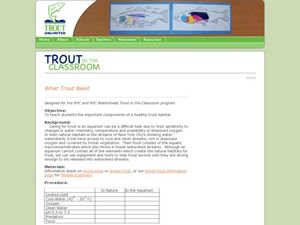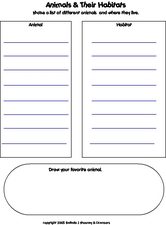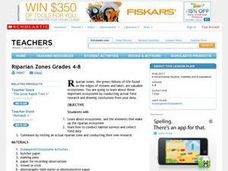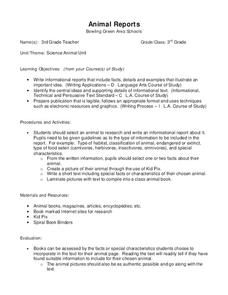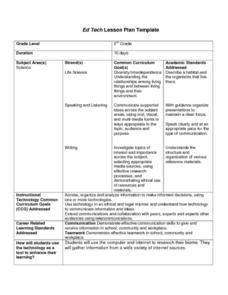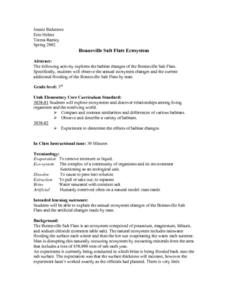Curated OER
"Rikki-Tikki-Tavi"
Students explore nature by reading stories in class. In this animal characteristics lesson, students read the story "Rikki-Tikki-Tavi," by Rudyard Kipling and identify the different animals mentioned in the book. Students review the...
Curated OER
What Trout Need
Students investigate the important components for a healthy trout habitat. In this fish habitat lesson, students discuss how the aquarium will simulate a trout's environment in nature. Students complete a trout information sheet to set...
Curated OER
Shelter/Refuge
Young scholars research shelters and places of refuge for animals and humans. In this shelters lesson, students read paragraphs about animal and human shelters. Young scholars complete an activity about beavers and shelters. Students...
Curated OER
Make a Rain Stick
Students create a rain stick to imitate the nature sounds in a rainforest habitat. In this rainforest habitat lesson, students create a rain stick to mimic the cultural tools used in the South American rainforest. Students use paper...
Curated OER
For Creative Minds: Mountain Ecosystems
For this mountain ecosystems worksheet, learners read information about mountain ecosystems and study various diagrams about the environment. Students match animals in the ecosystem to their descriptions.
Curated OER
Animals & Their Habitats
In this animal habitats worksheet, students list animals and their habitats. Students then draw their favorite animal in the provided space.
Curated OER
Describing the Physical Features of the Habitat
In this habitat instructional activity, students describe the physical features of the habitat. Students list information for the lay of the land, amount of water, tree features, elements exposure, and farming effects.
Curated OER
What Lives in Forests?
In this forest worksheet, students complete a graphic organizer by filling in 3 statements about what lives in a forest habitat.
Curated OER
What Lives in Oceans and Wetlands?
In this habitats worksheet, students compare and contrast what lives in an ocean habitat and a wetland habitat. This worksheet is a graphic organizer.
Curated OER
Animal Homes
In this animal homes worksheet, students will complete a graphic organizer by filling in 4 examples of places that animals live.
Curated OER
What is the Earth's Surface Like?
In this Earth's surface worksheet, students complete a graphic organizer by writing in 1 main idea and 4 supporting details describing the Earth's surface.
Curated OER
What Are Living Parts of Ecosystems?
In this ecosystem worksheet, students will write down 4 living parts of an ecosystem and then write in the effect these living things have on the ecosystem.
Curated OER
Habitats Pictures: Farm, Forest, Wetlands, Polar
In this science activity, students examine color pictures of 4 different habitats: farm, forest, wetlands and polar. There are no questions to answer.
Curated OER
Habitats Black and White Pictures: Farm, Forest, Wetlands, Polar
In this science worksheet, students examine black and white drawings of 4 habitats: farm, forest, wetlands and polar. There are no questions on the page.
Curated OER
Riparian Zones Grades 4-8
Students examine and analyze the Riparian Zones found on the edges of streams and lakes. They assess why those are such valuable ecosystems and then conduct actual field research on riparian zones and conclude by drawing conclusions from...
Curated OER
Animal Reports
Third graders choose an animal to research and write a report about. They determine the animals' habitat, animal classification, whether it is endangered or extinct, and the type of food it eats. Also, they add any special...
Curated OER
Pine Rockland Walk
Students take a field trip to the pine rockland area and identify three characteristics. In groups, they research the types of plants native to the area and the effect of non-native plants. To end the instructional activity, they...
Curated OER
Organisms and Habitats
Second graders investigate biomes and the plants and animals that are native to particular biomes. They participate in a class discussion, conduct Internet research on a selected biome, and create a shoebox biome using their Internet...
Curated OER
Who's There
Fifth graders, in groups, make a list of at least three animals that would survive well in a particular environment. After an allotted time, they pass their list to another group, where they will add to it. They discuss adaptations each...
Curated OER
Preparing for the New Haven Public School Science Fair Through Environmental Science
Students discover what type of effect that pesticides have on earthworms. They use three different types of pesticide and examine the external and internal effects that each have on earthworms. They maintain earthworms in habitats...
Curated OER
Underwater Habitats
Students make a hydrophone and attach it to their Sea Perch ROVs. They use the hydrophones in conjunction with the underwater cameras on the ROVs to explore their local aquatic environments.
Curated OER
Habitats
Students are introduced to various animals and their habitats. In groups, they must determine which animal skin matches the correct animal and identify the texture. They discuss the reason for the texture and width of the skin to end...
Curated OER
Bonneville Salt Flats Ecosystem
Young scholars discuss the annual ecosystem changes of the Bonneville Salt
Flats and the artificial changes made by man.They observe the annual ecosystem changes and the current additional flooding of the Bonneville Salt Flats by man.
Curated OER
Illinois' Habitats Happening
Students use the scientific inquiry method to examine the ecosystems and biomes in Illinois. Using the characteristics of a local habitat, they identify the best conditions for an ecosystem to survive and how a slight change can damage...



